I’ve always loved drawing with pencils. They let me capture subjects in a way that’s both real and deep. Whether you’re just starting or have been drawing for years, learning to draw with pencils is a journey. It’s full of challenges but also very rewarding.
In this guide, I’ll share the key techniques, tools, and strategies I’ve learned. These have helped me go from simple doodles to professional-quality drawings.
Creating amazing pencil drawings is not hard. You don’t need years of school or expensive art supplies. With practice and the right approach, you can make drawings that amaze people. Let’s explore how to make pencil drawing easy and professional.
Introduction to Pencil Sketching
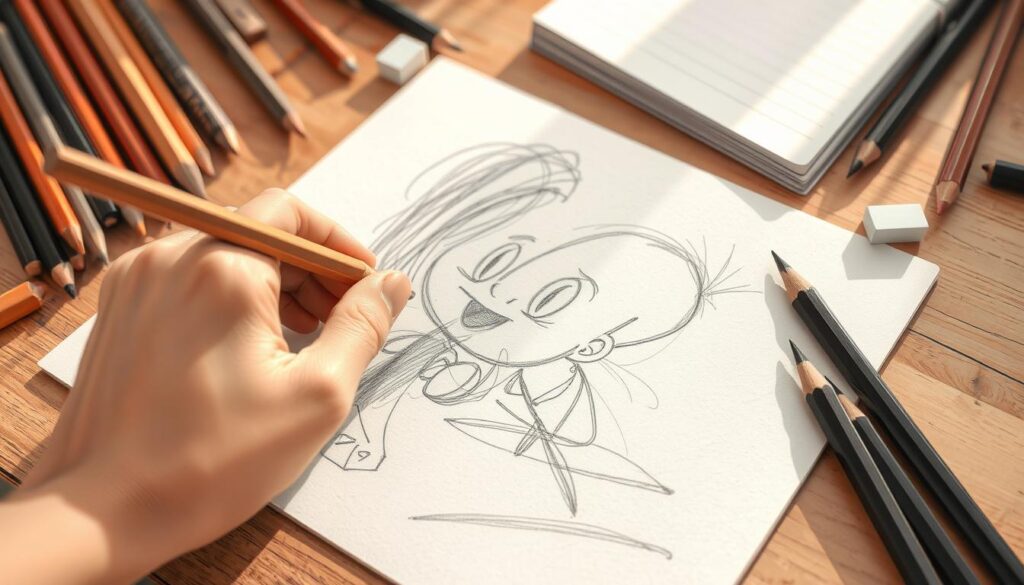
Pencil sketching is a fun and easy art form for everyone. It doesn’t matter if you’ve never drawn before. Learning the basics of pencil sketching can unlock a world of creativity. Start with simple exercises and move on to more complex subjects to improve your skills.
Understanding different pencils is key to pencil sketching. A 0.5 lead mechanical pencil is great for beginners. It’s durable, comfortable, and has a good eraser. Knowing the alphabet system for pencils helps you pick the right one for your art.
| Pencil Type | Characteristics |
|---|---|
| B (Black) | Soft and dark |
| H (Hard) | Light and precise |
| HB (Hard Black) | Medium hardness and darkness |
| F (Firm) | In-between hard and soft |
To start your pencil sketching journey, get a good beginner drawing tutorials set. The Faber-Castell pencil set is a great choice. It’s affordable and has many pencil grades. Use it with a premium sketchbook like the Strathmore 400 off-white sketchbook. This will help you create amazing pencil sketches that show your unique style.
Mastering Pencil Drawing Techniques
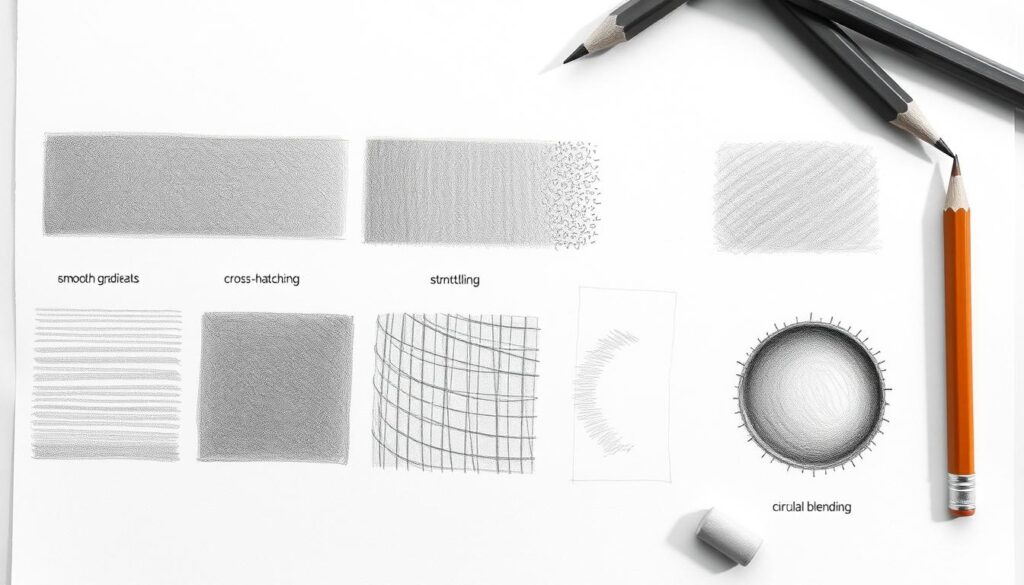
Learning pencil drawing takes a lot of practice and understanding. You need to know how to sketch with light, create lines, and refine shapes. It’s also key to break down subjects into simple shapes and proportions.
Pencil shading techniques are very important. They help show depth and dimension in your drawings. Good shading can make your drawings look three-dimensional and add texture and light effects.
The tutorial teaches you many pencil shading techniques. You’ll learn about hatching, cross-hatching, stippling, scumbling, and contour shading. Mastering these techniques lets you create different textures and effects in your stil life drawing with pencil. Practicing these basic pencil strokes will improve your shading skills.
The tutorial also covers how to create highlights and renderings. It teaches you to control your pencil better. By learning these skills, you’ll get better at pencil drawing and make professional-looking art.
Pencil Strokes for Different Effects
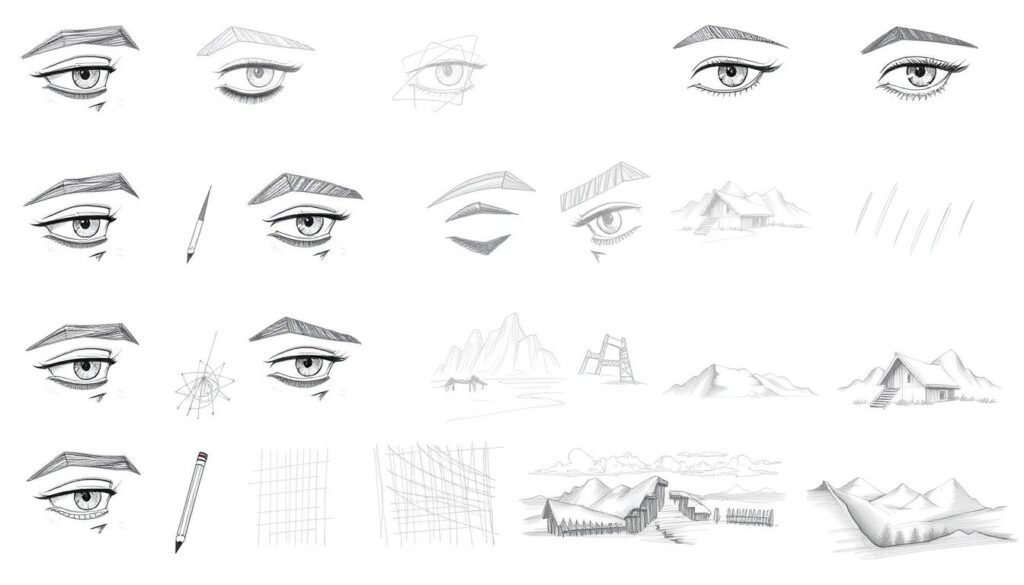
Pencil drawing is a versatile art form. It lets artists create many different marks and textures. By trying out various pencil strokes, you can unlock new creative possibilities and achieve amazing visual effects in your drawings.
Soft graphite pencils make darker, softer tones. Harder graphite pencils give crisper lines and more detailed work. Techniques like hatching and cross-hatching add depth and shading to your sketches. Stippling, using closely spaced dots, creates a darker, textured look with softer graphite.
Scribbling, with its erratic and overlapping lines, can lead to dramatic shading. On the other hand, controlled circular strokes make smooth transitions and blended effects. This allows you to blend light and shadow seamlessly.
Learning these pencil drawing techniques is key to creating a variety of visual effects in your art. Whether you’re doing simple illustrations, beginner pencil art, or advanced pencil drawing tutorials, knowing how to use different pencil strokes can improve your skills. It helps you create drawings that truly stand out.
pencil drawing easy with Circular Motions
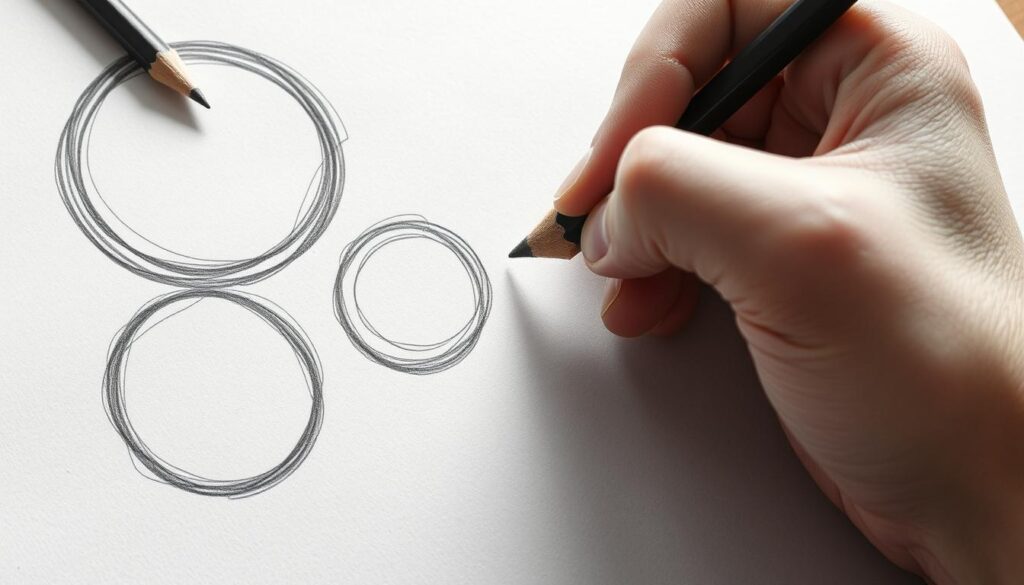
Pencil sketching becomes a joy when you learn circular motions. This method helps you draw smooth shapes and add depth to your art. It’s perfect for beginners who want to improve their pencil skills.
Start with a dark pencil (5B) and small circles to build your subject. Then, make your circles bigger and darker for shadows. Blend them well to get a natural look.
The circular motion is very useful. It works for all kinds of drawings, from simple sketches to detailed portraits. With practice, your drawings will look amazing.
Learning to draw with a pencil takes time, but it’s worth it. Try the circular motion and see how your drawings improve. With patience, you’ll soon make beautiful pencil art.
Smooth Shading and Blending Techniques
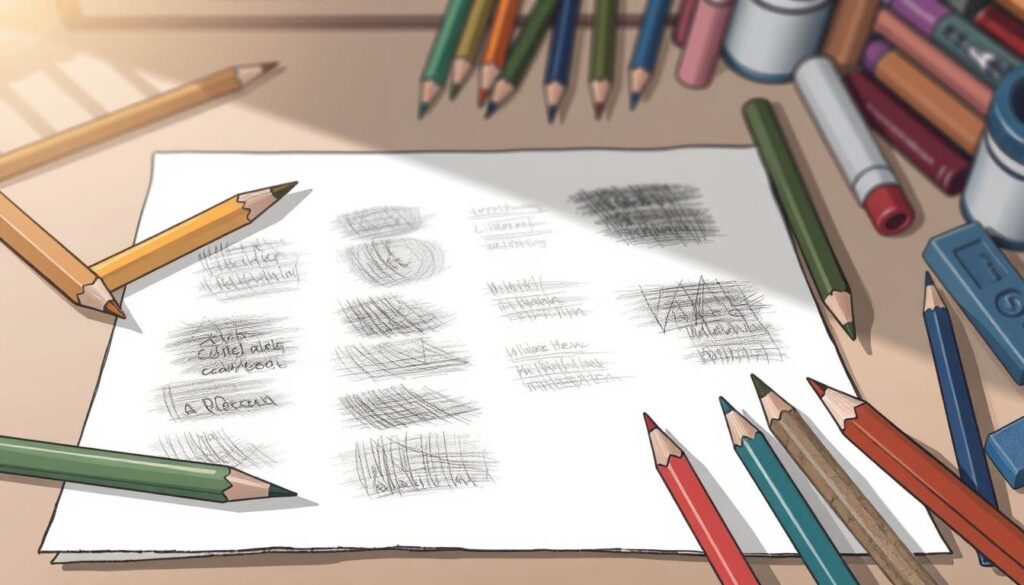
Learning smooth shading and blending is key to making your pencil drawings look professional. You can use layering, burnishing, and paper stumps to get seamless gradients and soft edges. This helps bring depth and volume to your work.
Shading is vital for showing volume in your drawings. You can use hatching, cross-hatching, blending, and more to add depth. Knowing how light affects your subject helps place shadows and highlights right.
Good shading makes your drawings look three-dimensional. Contrast in shading is important for showing form and light. It takes practice to get the shading just right.
| Pencil Grade | Typical Use |
|---|---|
| HB | Preliminary outlines, light areas |
| 4B, 6B | Mid-tones, shadows, detailing |
| 8B | Deepest shadows, accents |
To get smooth shading, start with light pressure and build up. Use a blending stump or cotton swab for a polished finish. Try different techniques like hatching and cross-hatching for texture.
Improving your pencil skills and understanding light and shadow is essential. With practice, you’ll create stunning pencil drawings that impress everyone.
Creating Highlights and Rendering
As you work on your pencil sketching techniques, adding highlights and details is key. Leaving some areas of the paper blank for highlights and using different pencil strokes can make your simple pencil art come alive. This adds depth and realism to your work.
Using the paper’s natural white for highlights is a great technique. By not drawing on certain areas, you can show where light hits. This makes your beginner illustrations look more real and three-dimensional.
Adding details and textures is another important part of pencil drawing. Different strokes, like hatching and stippling, can make surfaces look real. The way you use these strokes can make your drawings look even more realistic.
Blending is also vital for smooth transitions and soft edges. Try using your fingers, blending stumps, or paper towels to blend pencil marks. This helps your drawings feel connected and complete.
Remember, using highlights, rendering, and blending well is what makes pencil drawings stand out. By focusing on these techniques, you can improve your pencil sketching techniques and create simple pencil art that impresses.
Preparing Your Workspace and Materials
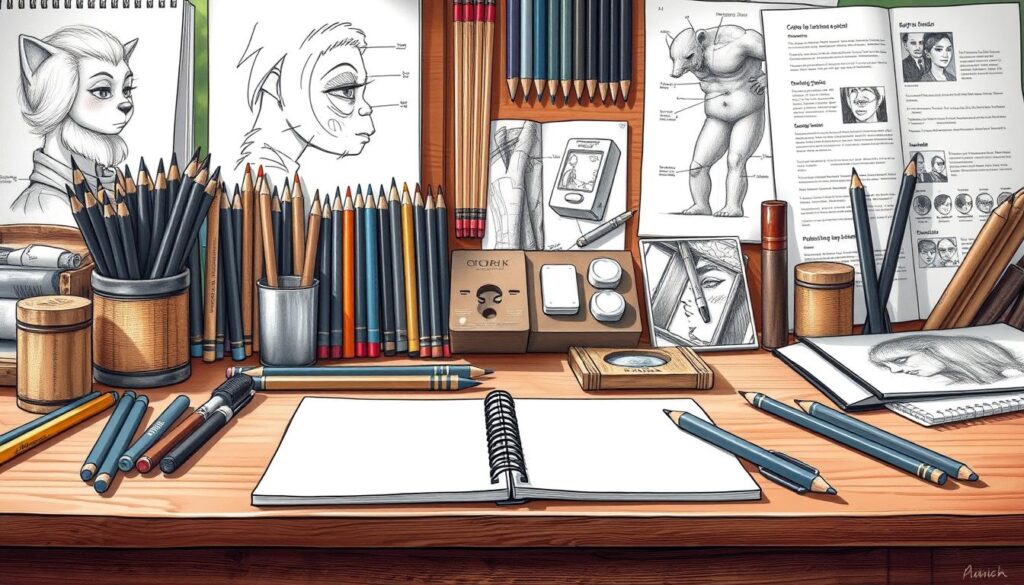
To make professional-looking pencil drawings, you need a good workspace. This means having the right pencil drawing supplies like pencils, paper, and other art supplies for beginners nearby. Also, think about the lighting and the surface you draw on to improve your work.
The pencils you pick are key for your drawings. Hard pencils like 2H or 3H are good for fine lines. Softer pencils, like 2B or 4B, are better for darker lines. Trying different pencils can help you get various looks in your drawings.
The paper you use is also important. Sketchbook paper around 60-70 lbs works well for both pencils and pens. For detailed or shaded drawings, use heavier paper like Bristol or watercolor, which is 100 to 140 lbs.
| Paper Weight | Suitable Uses |
|---|---|
| 20 lbs (Printer Paper) | Light sketching and practice |
| 60-70 lbs (Sketchbook) | General pencil and pen work |
| 100-140 lbs (Bristol, Watercolor) | Detailed, heavily shaded drawings |
It’s important to have a stable and comfy drawing surface. This could be a smooth drawing board or a sturdy sketchbook. It helps you stay in control and accurate while drawing.
Creating professional pencil drawings starts with the right pencil drawing supplies and a tidy workspace. By choosing quality materials and organizing your space, you’ll make stunning drawings that show off your talent.
Step-by-Step Drawing Process
Creating a solid step-by-step drawing process is essential for making great step-by-step pencil drawing. Start with a light sketch to get the basic shapes and proportions right. Then, refine the details and add shading to bring depth and realism.
For beginner drawing tutorials, learning about value and tone is vital. Focus on light, mid, and dark values. Apps like “See Value” or “Value Study” can help you spot these.
To make a realistic simple pencil art piece, begin with an outline and key shapes. Next, work on highlights, midtones, and shadows. Use different pencils and tools to get the right look.
Keep an eye on proportions, forms, and depth as you draw. Tutorials on drawing faces, eyes, and lips from different angles are super helpful.
Practice regularly and follow a step-by-step method to get better at step-by-step pencil drawing. With time and effort, you’ll make professional-looking drawings.
Developing Your Pencil Control
Getting better at pencil control is key for smooth lines and detailed drawings. Start by drawing straight lines, curves, and shapes. This helps improve your hand-eye coordination and muscle memory.
Control exercises are vital for beginners. They help you do doodles and sketches better. These exercises boost your fine motor skills and dexterity, important for both writing and art.
Try activities that improve fine motor skills, like crumpling paper or playing with Play-Doh. Also, practice moving your fingers with a pencil or flipping it like a windmill. These actions help you get better at controlling your pencil.
Mastering pencil control takes time and effort. Keep practicing, and you’ll see your skills improve. Enjoy the journey and feel proud of your progress with each session.
Practicing with Stil Life Drawings
As a beginner artist, practicing pencil drawing with simple subjects is rewarding. It helps you learn about proportion, shading, and detail. This way, you can improve without the complexity of more detailed subjects.
Start with basic shapes when drawing with pencil. Sketch the overall form and proportions first. Then, add details and use different strokes and shading to make your drawing look real.
Lighting and shadows are key in pencil art. Notice how light affects your objects, creating highlights and shadows. Use soft and hard pencils to capture these effects and add depth to your drawing.
Practicing with simple drawings improves your skills and sharpens your observation. It helps you understand form, texture, and light and shadow better. These skills are essential as you continue your drawing journey.
Whether drawing a vase, fruit, or everyday objects, enjoy the process. Let your pencil bring these scenes to life. With time and effort, you’ll create beautiful pencil art that shows your growing talent.
Pencil Portraits and Figure Drawing
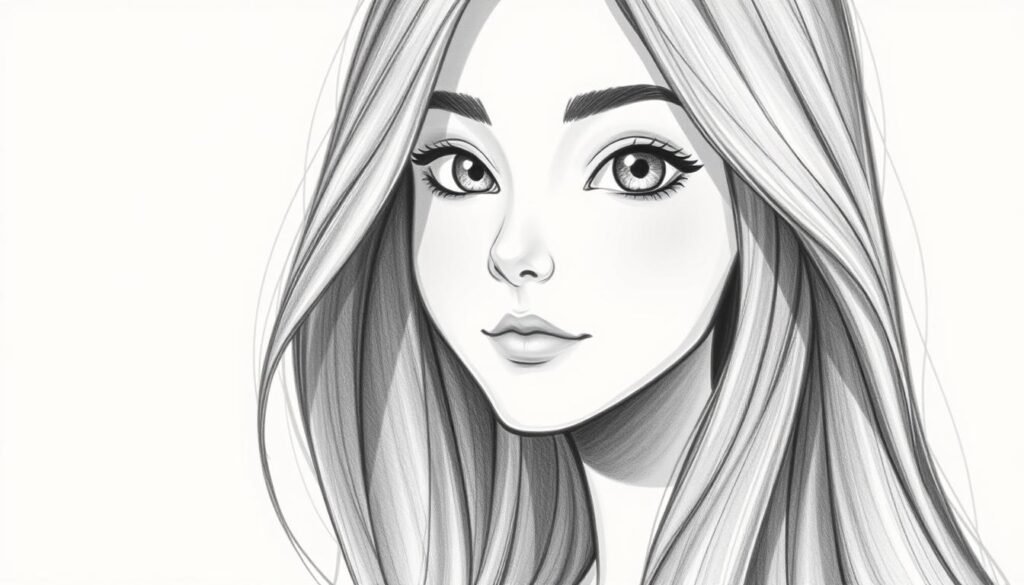
Creating pencil portraits can be both rewarding and challenging. Learning pencil sketching techniques and understanding face and figure anatomy are key. This way, you can make pencil portraits and figure drawings that look real.
For pencil portraits, focus on facial details. Study the eyes, nose, lips, and more to capture your subject’s unique look. Figure drawing also requires knowledge of the body’s structure. This helps in drawing the human form accurately and with depth.
Art tutorials for beginners are also important. They help in adding hair, clothing, and other details. These elements make your drawings more realistic and full of personality.
| Statistic | Value |
|---|---|
| Pencils Used | Mars Lumograph ranging from HB to 8B |
| Paper Used | Seawhites 220gsm heavyweight cartridge paper, A4 size |
| Other Tools | Staedtler Kneaded Eraser, Electric Eraser, Blending Stump |
| Pencil Grades for Shading | HB, 2B, 4B, 6B, 7B, 8B |
| Pencil Strokes | Emphasized to sculpt facial features |
| Drawing Time | 15 minutes per sketch, 1 hour for figure drawing |
By using the techniques from this guide, you can master pencil portrait drawing. With dedication, practice, and attention to detail, you’ll improve your skills. Soon, you’ll be able to create stunning pencil portraits and figure drawings.
Landscape and Nature Sketching
Pencil drawings are great for showing the beauty of nature. You can draw pencil landscape drawing or detailed plants and animals. Pencil sketching lets you see the textures, shapes, and light of the outdoors.
Try plein air sketching to improve your skills. This way, you can make beautiful pencil drawings that honor nature.
When doing pencil sketching tutorials, try different graphite pencils. Use 2H to 6B to get various shades and effects. Blend the pencil marks with a stump or your fingers for smooth transitions.
Focus on the small details, like tree bark patterns, flower petals, or bush branches. These details make your drawings come alive.
Be creative with simple pencil art by using different techniques. Try hatching, cross-hatching, layering, and blending. Use softer pencils for dark areas and harder ones for light areas to add depth.
With time and effort, you’ll get better at capturing nature’s beauty with just a pencil.
